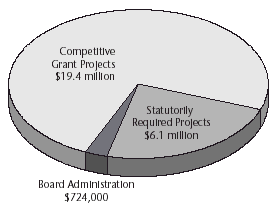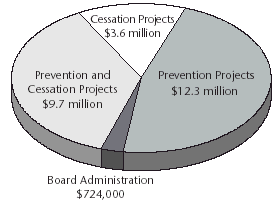|
The Board spent $26.2 million from
FY 1999-2000 through FY 2001-02.
Some tobacco control projects have been successful,
others less so.
Tobacco control projects statewide sometimes duplicate
efforts.
The Board should ensure it funds effective tobacco
control projects.
Key
Facts
and Findings
The Boardís $45.0 million appropriation for FY 1999-2000 through FY
2002-03 was funded by the Stateís settlement with tobacco companies.
Beginning in FY 2003-04, tobacco settlement funds will no longer be
available to support the Board.
Board-funded projects focused on prevention, cessation, and a
combination of prevention and cessation.
Two projects of the Center for Tobacco Research and Intervention
achieved their stated objectives.
Ten of the Medical Collegeís projects met at least some of their
stated objectives.
Competitive grant projects need independent evaluation to determine
their effectiveness.
The Governor has proposed eliminating the Tobacco Control Board and
consolidating efforts in DHFS.
|
|
1999 Wisconsin Act 9 created the Wisconsin Tobacco Control
Board in October 1999 to administer a statewide tobacco control
program. The Legislature appropriated a total of $45.0 million to the
Board for the four-year period from fiscal year (FY) 1999-2000
through FY 2002-03.
The Board funds various statewide and local
tobacco control projects. Most projects are funded through a competitive
grant process, but the Board is required by statutes to annually
distribute $2.0 million to the Thomas T. Melvin Youth Tobacco
Prevention and Education Program within the Department of Health and
Family Services (DHFS), $1.0 million to the University
of Wisconsin (UW) Madison Center for Tobacco Research and
Intervention, and $500,000 to the Medical College of Wisconsin.
The Board does not control how these three entities spend the funds.
1999 Wisconsin Act 9 required the Legislative Audit Bureau to
review how the Center and the Medical College used the Boardís funds. In
addition, we examined other Board-funded tobacco control projects. We
analyzed:
- the Boardís expenditures from FY 1999-2000 through
FY 2001-02;
- the types of projects that the Board supported; and
- the success that Board-funded projects have had in achieving their
stated goals.
Currently, the Board is supported by funds the State received from the
November 1998 Master Settlement Agreement with tobacco manufacturers.
In May 2002, the State securitized its annual tobacco settlement
payments and spent the resulting $1.3 billion. Therefore, beginning
in FY 2003-04, tobacco funds will no longer be available to fund the
Board.
As shown in Figure 1, the Board spent $26.2 million from
FY 1999-2000 through FY 2001-02, including $19.4 million on
competitive grant projects, $6.1 million on the three statutorily
required programs, and $724,000 on administration. Grant projects included
an anti-tobacco media and counter-marketing campaign, and community
coalitions organized by local public health departments.
Figure 1
Board Expenditures

The Boardís FY 1999-2000 through FY 2001-02
expenditures focused on prevention projects, cessation projects, and a combination of
prevention and cessation projects, as shown in Figure 2.
Figure 2
Focus of Expenditures

When measured against their individual program goals, the outcomes of
projects have been mixed.
Two of the Center for Tobacco Research and
Interventionís five projects achieved their objectives. One of these
successful projects is the Wisconsin Tobacco Quit Line, a toll-free telephone
service that provides cessation information and counseling. The Quit Line is the
most expensive of the Centerís Board-funded projects, with expenditures
of $1.5 million from FY 1999-2000 through FY 2001-02. From
May 2001 through June 2002, the Quit Line received more than
24,000 calls.
The Centerís successful regional outreach project employed six regional
outreach specialists to help health care providers, schools, and community
organizations implement tobacco cessation strategies. In December 2001, the
Center reported that its regional outreach specialists had trained more than
5,000 Wisconsin health care providers in cessation strategies; sent
cessation information to more than 3,000 primary care physicians in
cooperation with the State Medical Society; clarified cessation benefits with
each of the health maintenance organizations participating in the Medical
Assistance and BadgerCare programs; and promoted the Quit Line and other local
resources. Project expenditures were $1.0 million from FY 1999-2000
through FY 2001-02.
The Centerís three other projects, for which expenditures totaled $667,000,
achieved only some of their objectives. For example, through FY 2001-02,
the Center spent $357,400 for a survey to measure adult tobacco use. Because of
difficulties with the survey instrument and unexpected results, data did not
meet initial expectations.
The Medical College spent $500,000 for 19 research projects in
FY 2000-01. Ten of these projects accomplished at least some of their
objectives. For example, the Smoking Cessation Clinic, for which FY 2000-01
expenditures were $106,000, assessed 155 patients and trained a medical
resident and an intern in smoking cessation techniques. A less successful
project was the $9,000 Stress Kit project, which sought to reduce relapse rates
among women who had quit smoking. This project planned to recruit 100 women
but enrolled only 12.
Outcomes of the Boardís competitive grant projects, for which expenditures
totaled $19.4 million over the past two fiscal years, have been similarly
mixed. For example, the Media and Counter-marketing project, which spent
$6.8 million through FY 2001-02, resulted in greater recall of
anti-tobacco messages and knowledge about tobacco industry advertising
practices. Another project, which is one of two Young Adult Pilot studies, aimed
to reduce smoking rates among UW-Oshkosh students by 4.0 percent but
reported achieving a reduction rate of 29.0 percent. That projectís
expenditures were $216,000 through FY 2001-02.
In contrast, several competitive grant projects encountered difficulties in
meeting their objectives because they were unable to recruit enough
participants. For example, a second Young Adult Pilot study project to
serve 18- to 24-year olds in the workplace anticipated 75 to
100 participants; however, only 12 participants stayed in the study
for the six-month period intended to measure cessation rates. Six of these
12 participants were not smoking when the evaluation ended. The programís
expenditures through FY 2001-02 were $94,000.
The number of participants in the Wisconsin Ethnic Network project is
unknown, and this competitive grant project did not accomplish its goal to
implement tobacco control strategies during the first year of its contract with
the Board, which ended in March 2002. Instead, efforts and expenditures
were related to building coalitions and developing culturally appropriate
advertising materials. The project had expenditures of $551,300 through
FY 2001-02.
The Board has no authority to direct the activities of the Center, the Melvin
Program, or the Medical College. In addition, other state programs that are not
funded or controlled by the Board, including programs in DHFS and the Department
of Public Instruction, have tobacco control elements.
Although the Board has
attempted to informally coordinate tobacco control activities, some projects
have duplicated efforts. We provide suggestions for improving project
coordination.
The Board has not always acted consistently in determining grant periods,
monitoring expenditures, and allowing competitive grant recipients to purchase
cessation medication. We provide two recommendations for improving the Boardís
management of its competitive grants.
The Board requires the projects it funds through the competitive grant
process to collect information about project effectiveness. For 2003, it
approved additional funding for all competitive grant projects that had
previously received funding, as well as for three new projects.
The Board has contracted with the UW Comprehensive Cancer Center
to monitor and evaluate tobacco control efforts and statewide smoking rates and attitudes,
and to assist local coalitions in evaluating their programs. Through December 2002,
the Monitoring and Evaluation Program established under this contract has
focused on monitoring activities rather than on evaluating results. The
UW Comprehensive Cancer Center plans to complete evaluation reports for the
Boardís projects in spring 2003.
Our recommendations address the need for the Wisconsin Tobacco Control Board
to:
- use the Monitoring and Evaluation Programís reports to assist it in
making decisions about which projects should receive continued funding
(p. 52);
- revise administrative rules to either allow competitive grant recipients
to purchase medication for the cessation of tobacco use or ensure that grant
funds do not pay for medication expenses
(p. 52);and
- use consistent grant periods and monitor grant recipientsí expenditures
on a regular basis so that unspent funds can be reallocated to other tobacco
control projects
(p. 53).
The Legislature will need to decide funding for the 2003-05 biennium.
For example, it could allocate:
- $25.0 million annually, the amount stipulated in 2001 Wisconsin
Act 109;
- less than the $15.3 million the Board received in each year of the
current biennium; or
- $15.0 million annually, as proposed by the Governor.
The Legislature could also consider ways to improve coordination among the
Stateís anti-tobacco efforts. For example, it could give the Board explicit
authority to determine how the Melvin Program, the Center, and the Medical
College spend the Boardís funds, or consider the Governorís proposal to
eliminate the Board and consolidate efforts within DHFS.
|